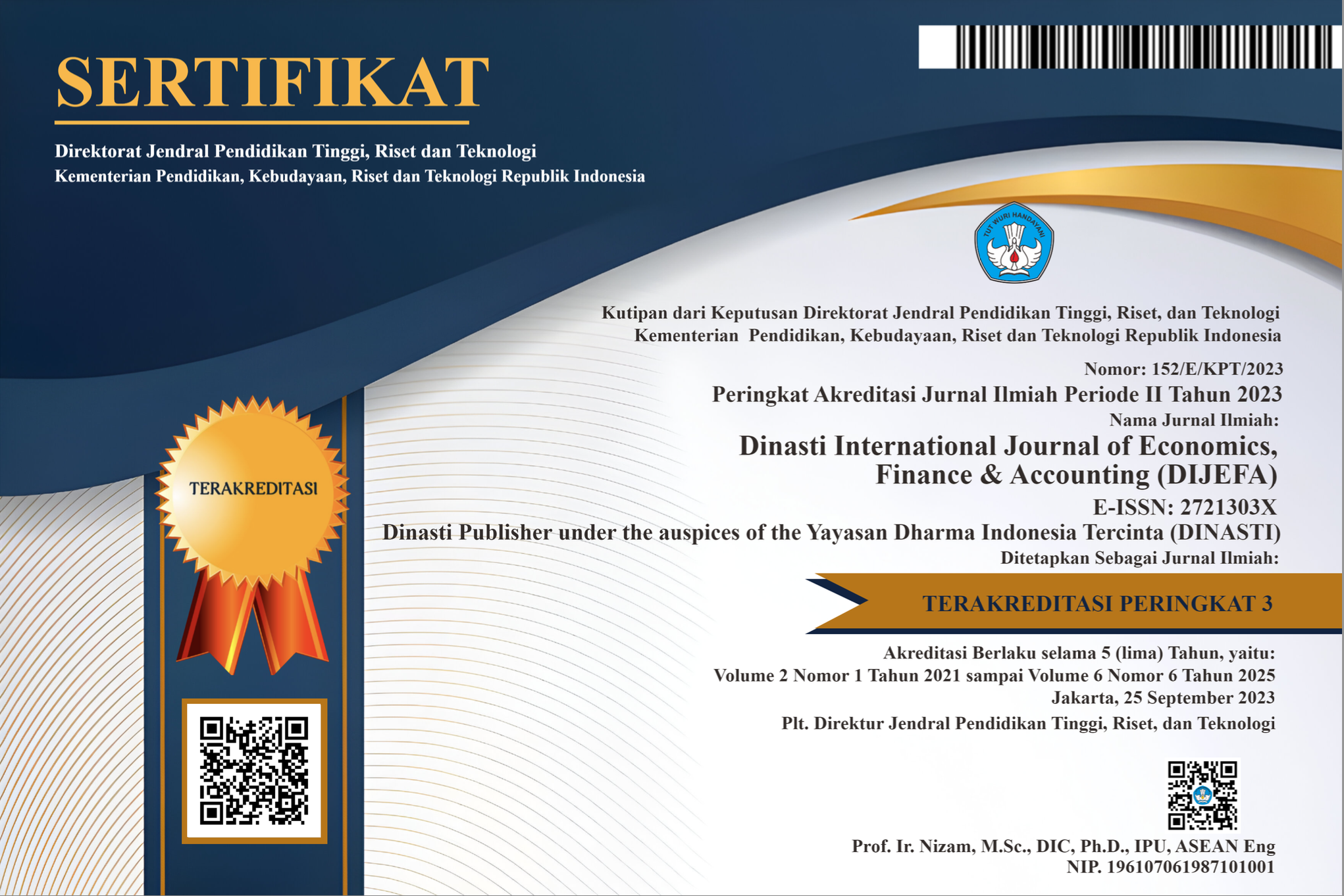Influence of Religiosity, Service Quality, Customer Intimacy and Imagetocustomer Loyaltywithtrustas Mediation In Indonesian Syariah Bank In Bengkulu
DOI:
https://doi.org/10.38035/dijefa.v6i1.4053Keywords:
religiosity, service quality, brand image, customer intimacy, trust, customer loyalty.Abstract
This study aims to analyze the effect of religiosity, service quality, brand image, customer intimacy on customer loyalty mediated by trust. The research method is quantitative, and the primary data is collected through an online questionnaire. Participants in this survey consisted of 173 Indonesian Islamic bank customer respondents. The analytical method in this survey uses SmartPLS Version 4.2.9.2 analysis to filter and analyze data. The results of the study show that (1) Brand image has a positive and significant effect on customer loyalty; (2) Brand image has a positive and significant effect on trust (3) Customer intimacy has a positive and significant effect on customers (4) Religiosity has a positive and significant effect on customer loyalty (5) Religiosity has a positive and significant effect on trust (6) Service Quality has a positive and significant effect on customers (7) Service Quality has a positive and significant effect on (8) Trust has a positive and significant effect on customer loyalty (9) Religiosity has a positive and significant effect on customer loyalty through trust. (10) Service quality has a positive and significant effect on customer loyalty through trust. (11) brand image has a positive and significant effect on customer loyalty through trust
References
Abdullah. (2015). Quantitative Research Methodology. Yogyakarta: Aswaja Pressindo.
Aji, DSK, Setyawati, S. M & Rahab, R. (2019). Analysis of the influence of religiosity, service quality, and image on customer loyalty with trust as a mediator 1. 23.78-94
Amin, M., Isa, Z. and Fontaine, R. (2013), “Islamic banks: contrasting the drivers of customer satisfaction on image, trust, and loyalty of Muslim and non-Muslim customers in Malaysia”, International Journal of Bank Marketing, Vol. 31 No. 2, pp. 79-97.
Anggriawan, F., Djoko Widodo, D., Kartini, T., Pd, S., & Pd, M. (2015). The Influence of Customer Intimacy on Customer Loyalty of Bank Rakyat Indonesia Syariah Jember Branch. Student Scientific Article, I(1), 1–7.
Aulia, Muhammad Raziq. Hafasnuddin. 2019. The Influence of Service Quality, Satisfaction and Religiosity on Customer Loyalty of Bank Syariah Mandiri Banda Aceh Branch. Scientific Journal of Management Economics Students. Vol 06 No 01.
Azam, S. Mostafa and Ali A. (2020) EFFECTS OF CUSTOMER VALUE AND SERVICE QUALITY ON CUSTOMER LOYALTY: MEDIATION ROLE OF TRUST AND COMMITMENT IN BUSINESS-TO-BUSINESS CONTEX Management Research and Practice Volume 12, Issue 1 / March 2020
Bangert-Drowns, R.L., Hurley, M.M., & Wilkinson, B. (2004). The effects of school-based writing-to-learn interventions on academic achievement: A meta-analysis. Review of Educational Research, 74(1), 29–58.https://doi.org/10.3102/00346543074001029
Brunner, TA, Markus, S., & Klaus, O. (2008), "Satisfaction, image and loyalty: New versus experienced customers". European Journal of Marketing, 42(9/10), 1095-1105.
Bugel, MS, Verhoef, PC and Buunk, AP (2011), "Customer intimacy and commitment to relationships with firms in five different sectors: preliminary evidence", Journal of Retailing and Consumer Services, Vol. 18 No. 4, pp. 247-258.
Brock, JKU and Zhou, JY (2012), “Customer intimacy”, Journal of Business & Industrial Marketing, Vol. 27 No. 5, pp. 370-383.
Cooper, DR and Schindler, PS (2003), “Business Research Methods,” 8ed Boston: McGraw-Hill. Companies
Delgado, B. E., & Aleman, J. L. M. (2001). Brand trust in the context of customer loyalty. European Journal of Marketing, Vol. 15 (11/12), 1238-1258.
Diamant, J. (2019, April 01). The countries with the 10 largest Christian population and the 10 largest Muslim population.
Ghozali and Latan, (2015) “Partial Least Squares, Engineering Concepts and Applications Using SmartPLS 3.0 Program”. 2nd Edition. Diponegoro University Publishing Agency, Semarang. Pages: 77, 81, 78, 83
Hoq, M.2., Sultana, N., Amin, M., (2010), The effect of trust, customer satisfaction and image on customers' loyalty in Islamic Banking Sekor, vol 17 no. I ppr 70-93
Leninkumar, Vithya. 2017. The Relationship between Customer Satisfaction and Customer Trust on Customer Loyalty. International Journal of Academic Research in Business and Social Sciences. Vol 7 No 4. Doi: 10.6007/IJARBSS/v7-i4/2821.
Manjunath, S. J. and Aluregowda. 2013. Impact of Service Quality on Customer Satisfaction at AXIS Bank, International Journal of Management and Social Sciences Research (IJMSSR), Vol. 2, no. 3, pp. 63-69
Muslim, A., Zaidi, I. and Rodrigue, F. (2013), “Islamic Banking: Comparing the drivers of customer satisfaction on image, trust and loyalty of Muslim and non-Muslim customers in Malaysia”, International Journal of Bank Marketing, Vol. 31, pp.79-97
Omoregie, OK, Addae, JA, Coffie, S., Ampong, GOA, Ofori, KS 2018. Factors influencing consumer loyalty: evidence from the Ghanaian retail banking industry. International Journal of Bank Marketing. Vol. 37 No. 3, pp. 798-820. Doi: 10.1108/IJBM-04-2018-0099.
Rasheed, HMW, Sajid, M., Shahid, N., Ahmad, M., Khalid, J., Khizar, HMU, Khan, WA 2015. Factors affecting Customer Loyalty in Banking Sector: A study on Banks in Bahawalpur (Pakistan) . International Journal of Accounting and Financial Reporting. Vol. 5, no. 1. Doi: 10.5296/ijafr.v5i1.7726.
Rofiqo, A., Addinata, VH, & Sari, DN (2021). The Effect of Service Quality on Loyalty with Trust and Satisfaction as Mediator Variables of Islamic Banks in Ponorogo. Etihad: Journal of Islamic Banking and Finance, 1(1), 1–11.
Rizwan., et al (20l4), "Incorporating Attitude Towards Islamic Banking in an Integrated Service Quality, Satisfaction Trust and Loyalty Model", lnlentational Jounlal of Accounting and Financial Reporting, vol 4 No. 2, pp: 456-477
Sekaran, Uma. (2006), “Research Method For Business: Research Methodology For Business”. Salemba Empat. Jakarta.
Setyawati, SM Raharja, MC, (2018)., Trust Dimensions Model in Creating Loyalty Stage for Seryice Consumers of Sharia Rurat Baling, European Research Studies Journal yolume X)Q, Issue 1, pp. 507-518 Marketing. Jakarta: Prenada Media
Shera, AAAA (2021). The Influence of Emotional Attachment and Religiosity in Building Customer Loyalty through Customer Satisfaction (Study on Users of Halal-Labeled Beauty Products in Malang City).
Siddiqi, KO 2011. Between Service Quality Attributes, Customer Satisfaction and Customer Loyalty in the Retail Banking Sector in Bangladesh, International Journal of Business and Management, Vol. 6, no. 3, pp. 12- 36.
Sugiyono. 2019. Quantitative, Qualitative and R & D Research Methods. Bandung: Alfabeta.
Suhartanto, D., Gan, C., Sarah, IS, & Setiawan, S. (2019). Loyalty towards Islamic banking: service quality, emotional or religious driven? Journal of Islamic Marketing, 11(1), 66–80.
Tabrani, M., Amin, M., & Nizam, A. (2018). Trust, commitment, customer intimacy and customer loyalty in Islamic banking relationships. International Journal of Bank Marketing, 36(5), 823–848.https://doi.org/10.1108/IJBM-03-2017-0054(www.OECD.org:2018).
Umar, H. 1999. Corporate Strategy Research. Jakarta: PT. Gramedia Pustaka Utama.
Wahyoedi, S., (2017)., "The Effect of Religiosity, Service Quality, and Trust on Customer l-oFlty Islamic Banking in Bogor, Indonesia, International Review of Management and Business Research, Vol. 6 No. 1, pp. 331-340.
Downloads
Published
How to Cite
Issue
Section
License
Copyright (c) 2025 Nara Andesta, Seprianti Eka Putri

This work is licensed under a Creative Commons Attribution 4.0 International License.
Authors who publish their manuscripts in this journal agree to the following conditions:
- The copyright on each article belongs to the author(s).
- The author acknowledges that the Dinasti International Journal of Economics, Finance & Accounting (DIJEFA) has the right to be the first to publish with a Creative Commons Attribution 4.0 International license (Attribution 4.0 International (CC BY 4.0).
- Authors can submit articles separately, arrange for the non-exclusive distribution of manuscripts that have been published in this journal into other versions (e.g., sent to the author's institutional repository, publication into books, etc.), by acknowledging that the manuscript has been published for the first time in the Dinasti International Journal of Economics, Finance & Accounting (DIJEFA).


























































